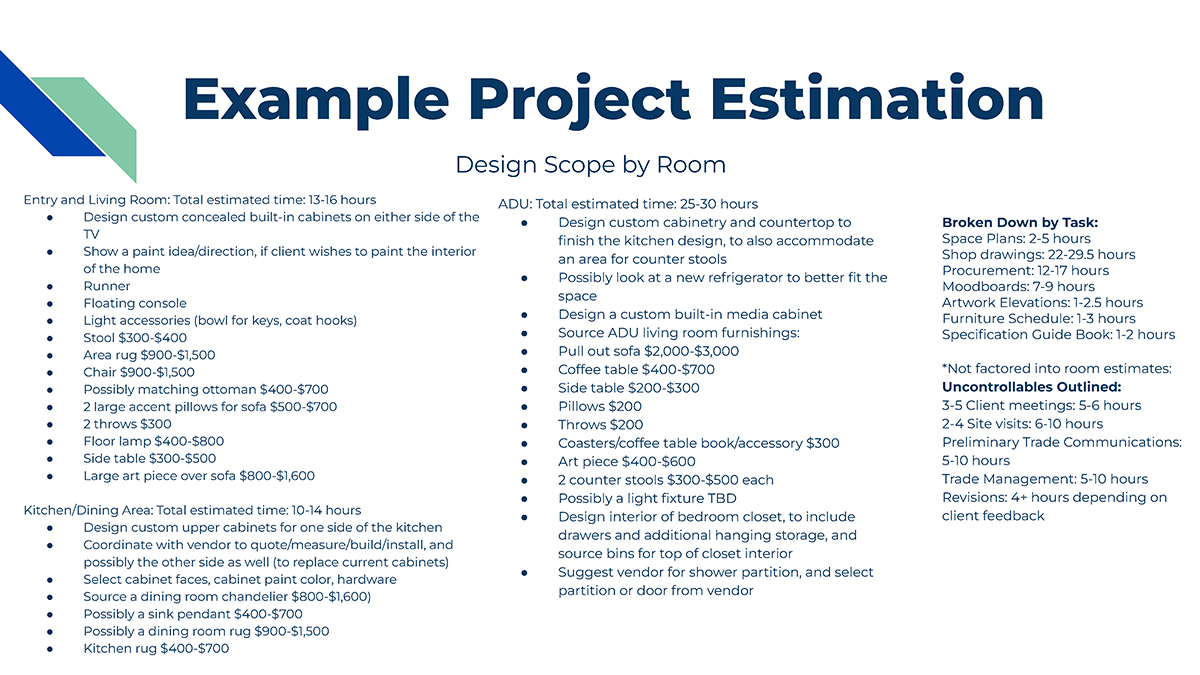When it comes to building a successful interior design business, pricing is a cornerstone of profitability. It is important to establish a fee structure that shows your worth to your clients and guarantees you are compensated fairly for your services. While there are many different ways to bill for services, some of the most common interior design fee structures include an hourly rate, a flat fee retainer, and a rate based on square footage. There are advantages and disadvantages to each model, so it is wise to research them thoroughly before choosing the one that best meets your needs. To save you from hours of digging for answers, our team at 4Dbiz has compiled some of our own research and expertise in this blog. Keep scrolling for a comparison of each interior design fee structure at a glance.
Hourly Rate
If you are planning to offer your services by the hour, be sure to consider business expenses and competition when setting your hourly rate. It should be calculated thoughtfully, with a little bit of leeway to account for unexpected surprises that may arise during the design process. We know that calculating your hourly rate can be challenging if there are many variables to consider, so we have put together an Hourly Rate Calculator to do the math for you, based on your financial goals. Check it out here!
Be sure to show your clients a detailed outline of the estimated hours needed to complete the project as well. We suggest presenting an hour allocation menu that explains how long specific tasks typically take. This way, your client knows what to expect throughout the process. Check out our hour allocation template to help you get started.
Pros:
- Project Longevity: Some projects drag on, due to shipping or client indecisiveness. With this system, you can continue to work and bill the clients for as long as you need, making it easier to see a project to completion.
- Budget Friendly: Billing as hours accumulate means that there is a smaller cost upfront. This may be more attractive to clients who are on a budget, as they have the option to pay bit by bit instead of all at once.
Cons:
- Frequent Billing: You will need to be diligent about consistently billing the client, in order to stay organized and ensure that the project is paid as it progresses. We recommend billing bi-monthly or monthly to keep things simple and consistent for your clients.
- More Administrative Correspondence: Frequent billing requires more administrative correspondence with the client overall. You will need to communicate how much time has been spent and what has been accomplished.
When you provide hourly services, it is extremely important to be diligent about tracking your time whenever you work on a project. This will save you lots of time and stress later when you need to bill your client, and it will help you ensure that you are billing accurately.
Flat Fee Retainer
Estimating project hours becomes even more crucial if you choose to provide services with a flat fee retainer. With this fee structure, your compensation and profitability depends heavily on your estimation of hours at the beginning of the project. This estimate is necessary for you to determine an appropriate fee amount. You should break the project into phases. Include an estimate of hours for each phase and explain what you expect to accomplish during each phase. We suggest supplementing the initial estimate with weekly time logs sent to your client. This will help ensure that there is no confusion about how time is being used.
Pros:
- Upfront Payment: Costs are paid at the beginning of a project, so you do not have to worry about billing as you complete work. With this structure, you also avoid delays in the project that are caused by late client payments.
- Less Administrative Correspondence: This helps to streamline communication and minimize the amount of emails in your inbox and your client’s.
Cons:
- Risk of Inaccurate Estimation: Unpredictable circumstances will arise sometimes. This can make it difficult to estimate how long a task will actually take you. But beware: estimating the project incorrectly can have a negative impact on your profitability or client satisfaction.
- Risk of Losing Profit: If you get stuck in a never-ending project, you are at risk of losing profit. A thorough contract with protection clauses can help you avoid this! Learn more here.
No matter how precisely you try to estimate your time, there are bound to be some unexpected situations that are out of your control. We recommend combining flat fee and hourly rates into one hybrid model instead of just relying on one interior design fee structure. Be sure to specify a maximum number of hours that you are willing to work for the estimated fee. Include a clause in your contract stating that indicated hours are an estimation and additional fees may occur. This allows you to bill for additional time at an hourly rate if a project takes longer than expected.

Square Footage Rate
Another way to price your services is to bill based on square footage. It is a straightforward model that gives the client some flexibility to add on additional work as the project progresses. It also ensures that you are being compensated fairly for your time. The larger the footprint of the project, the higher the cost will be. This model does not require a detailed breakdown of hours like the other two, but we highly recommend it. It will help you make sure everyone is on the same page.
Pros:
- Easy to Sell: This model is simple and clear for most clients to understand. All of the costs are laid out upfront for them. This can make it easier for you to close on jobs.
- Less Administrative Correspondence: Since costs are billed upfront, that means you do not have to send monthly or bi-monthly invoices. However, it is still a good idea to send weekly time logs or updates. This helps ensure that your clients are aware of your progress.
Cons:
- Limited ROI Protection: This model does not account for the fact that sometimes small projects can be just as much work as large ones. If there are delays in the process or the client is indecisive, you may end up spending more time working than you anticipated. This can significantly hinder your ROI.
- Greater Possibility of Getting Stuck in a Project: It can be more challenging to exit a never-ending project. Clients will expect you to continue working until progress on the billed square footage is complete.
This comparison is not to say that one interior design fee structure is better than another. Determining which structure you should use is a matter of weighing the pros and cons with your individual business needs. But it is much easier to identify these needs when you have a strong foundation for your business. If you need support to develop your business foundation, schedule a strategy session with 4Dbiz Founder and solopreneur, Shayna Rose. She can help you make an actionable plan, refine your goals, build an effective pricing model, and put profit at the center of your business.

